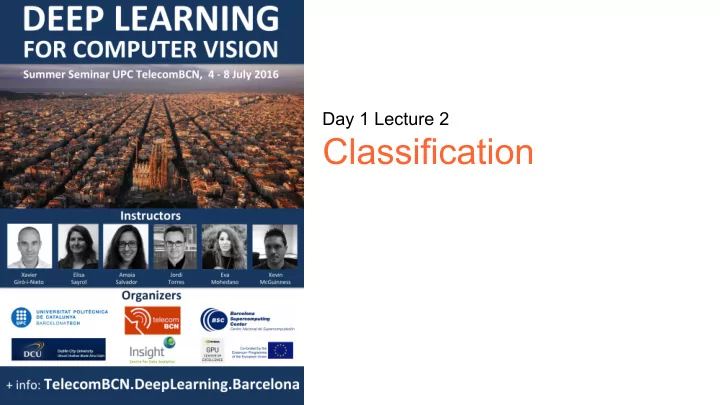

Day 1 Lecture 2 Classification
Image Classification Set of predefined categories [eg: table, apple, dog, giraffe] Binary classification [1, 0] DOG 2
Image Classification 3
Image Classification pipeline Dog 4 Slide credit: Jose M Àlvarez
Image Classification pipeline Dog Learned Representation 5 Slide credit: Jose M Àlvarez
Image Classification pipeline Dog Learned Representation Part I: End-to-end learning (E2E) 6 Slide credit: Jose M Àlvarez
Image Classification: Example Datasets training set of 60,000 examples test set of 10,000 examples 7
Image Classification: Example Datasets 8
Training set 2.1 3.2 4.8 0.1 0.0 2.6 0 3.1 1.4 2.5 0.2 1.0 2.0 1 N training examples 1.0 2.3 3.2 9.3 6.4 0.3 1 N (rows) 2.0 5.0 3.2 1.0 6.9 9.1 0 9.0 3.5 5.4 5.5 3.2 1.0 0 D features (columns)
Train/Test Splits split Training Learning algorithm data shuffle fit(X, y) (70%) Shuffled Dataset data Model NO! Test data Prediction algorithm (30%) predict(X) Out-of-sample Compute error/accuracy Predictions error estimate score(X, y)
Metrics Confusion matrices provide a by-class comparison between the results of the automatic classifications with ground truth annotations.
Metrics Correct classifications appear in the diagonal, while the rest of cells correspond to errors. Prediction Class 1 Class 2 Class 3 Class 1 x(1,1) x(1,2) x(1,3) Ground Class 2 x(2,1) x(2,2) x(2,3) Truth Class 3 x(3,1) x(3,2) x(3,3)
Metrics Special case: Binary classifiers in terms of “Positive” vs “Negative”. Prediction Positives negative False True Positives negative positive (TP) (FN) Ground Truth False True negative negative positives (FP) (TN)
Metrics The “accuracy” measures the proportion of correct classifications, not distinguishing between classes. Binary Prediction Prediction Positives negative Class 1 Class 2 Class 3 False Class 1 x(1,1) x(1,2) x(1,3) True positive Positives negative (TP) (FN) Ground Ground Class 2 x(2,1) x(2,2) x(2,3) Truth Truth False positives True negative Negative Class 3 x(3,1) x(3,2) x(3,3) (FP) (TN)
Metrics Given a reference class, its Precision (P) and Recall (R) are complementary measures of relevance. Example: Relevant class is “Positive” in a binary classifier. Prediction Positives Negatives True False Positives positive negative (TP) (FN) Ground Truth False Negatives positives (FP) "Precisionrecall" by Walber - Own work. Licensed under Creative Commons Attribution-Share Alike 4.0 via Wikimedia Commons - http://commons.wikimedia.org/wiki/File:Precisionrecall. svg#mediaviewer/File:Precisionrecall.svg
Metrics Binary classification results often depend from a parameter (eg. decision threshold) whose value directly impacts precision and recall. For this reason, in many cases a Receiver Operating Curve (ROC curve) is provided as a result. True Positive Rate
Image Classification pipeline Dog 17 Slide credit: Jose M Àlvarez
Linear Models f(x, w ) = ( w T x + b) Mapping function to predict a score for the class label CS231n: Convolutional Neural Networks for Visual Recognition
Sigmoid Logistic Regression Activation function: Turn score into probabilities f(x, w ) = g( w T x + b)
Neuron
Data hygiene Split your dataset into train and test at the very start ● Usually good practice to shuffle data (exception: time series) Do not look at test data (data snooping)! ● Lock it away at the start to prevent contamination NB: Never ever train on the test data! ● You have no way to estimate error if you do ● Your model could easily overfit the test data and have poor generalization, you have no way of knowing without test data ● Model may fail in production
Recommend
More recommend